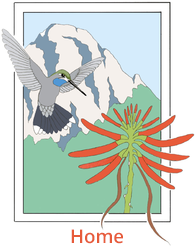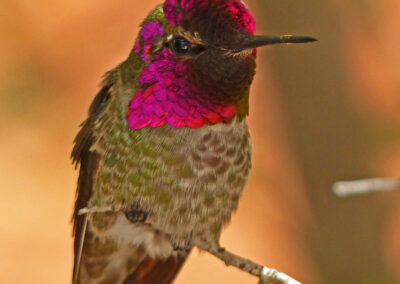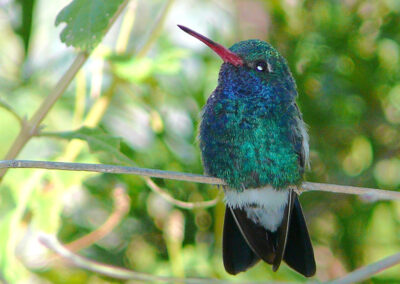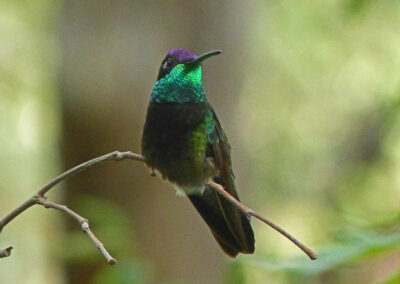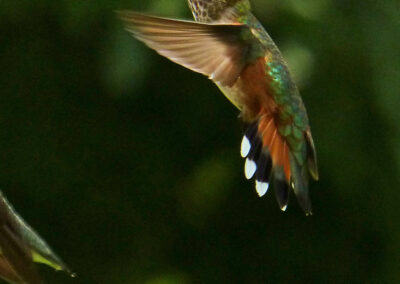Birding
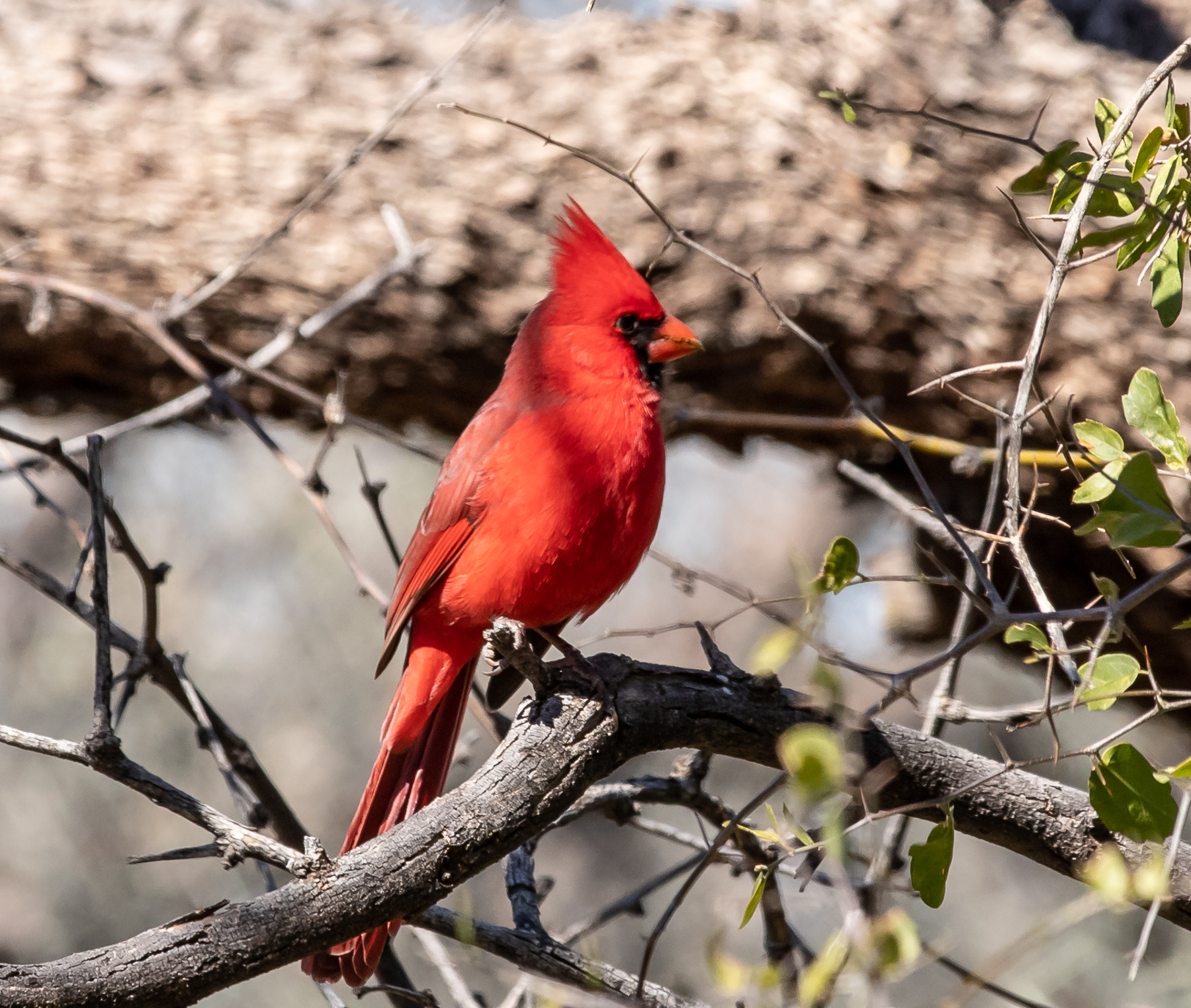
One of the most famous birding areas in the United States, is a north-facing valley in the Santa Rita Mountains with riparian woodland along an intermittent stream, bordered by mesquite, juniper-oak woodlands, and pine forests. Madera Canyon is home to over 250 species of birds, including 15 hummingbird species. Visitors from all over the world arrive in search of such avian specialties as the Elegant Trogon, Elf Owl, Sulphur-bellied Flycatcher, Red-faced Warbler and Painted Redstart. A comprehensive bird list published by FoMC is available at the Proctor Visitor Info Station and at trail heads.
The road to Madera Canyon enters through desert grasslands and ends in juniper-oak woodland, where hiking trails lead up in the “sky island” through pine-oak woodland to montane conifer forest and the top of Mt. Wrightson (elevation 9,453 feet). The spectrum of birds found in these varied habitats includes four species of tanagers: Summer at Proctor Road, Hepatic starting at Madera Picnic Area, Western up the trails in the conifers, and Flame-colored as an occasional breeder. Hummingbirds, owls and flycatchers are also very well represented in this area. Montezuma Quail are inconspicuous but present near grassy oak-dotted slopes.
Below Madera Canyon, in the Santa Rita Experimental Range, can be found birds of the desert grasslands and brush, including Costa’s Hummingbird, Varied Bunting, Blue Grosbeak, Scaled Quail, Phainopepla, Botteri’s, Cassin’s, Black-throated, Brewer’s, and Rufous-winged Sparrows.
At Proctor Road, most birders walk the productive first section of the trail to Whitehouse Picnic Area to find Northern Beardless-Tyrannulet, Sulphur-bellied Flycatcher, Bell’s Vireo, Lucy’s Warbler, Blue Grosbeak, Varied Bunting, Summer Tanager, and sometimes Yellow-billed Cuckoo. The dirt road shortly above the parking lot may have Western Scrub-Jays and a Crissal Thrasher.
Farther up the road, the Madera Picnic Area has Acorn and Arizona Woodpeckers, Mexican Jay, Bridled Titmouse, Painted Redstart, and Dark-eyed Junco. Three Myiarchus flycatchers , Western Wood-Pewee and Hepatic Tanager can be found here in season. Watch overhead for Zone-tailed Hawk among the Turkey Vultures.
At the end of the road at the parking lot, the trailhead leads to Old Baldy. Elegant Trogons are most often found along the first mile of either the Super Trail of the Carrie Nation trail. Hermit Thrush, American Robin, Plumbeous Vireo, Painted Redstart, and Dusky-capped Flycatcher are common along the trails. Yellow-eyed Juncos breed higher up towards Josephine Saddle.
Night birding is a Madera Canyon highlight, especially in May. Listen for Western and Whiskered Screech-Owls, Elf Owls and the much rarer Flammulated and Spotted Owls. Whip-poor-wills are in the forest and Common Poorwills can be heard near Proctor and below. Lesser Nighthawks, Barn and Great Horned Owls often fly across the road through the beam of your headlights as you approach the canyon.
The far-reaching, rapid “Ku-WARK, Ku-WARK, Ku-WARK” echoes through Madera Canyon, sounding like a distant dog barking. Easier to hear one than to see one? Yes, because the Elegant Trogon sits quietly on a branch with his green back toward you, blending perfectly into the foliage. After five or ten minutes, he might swoop down for an insect — then sit on the next perch for a while. Females are duller, browner and harder to see, even though they too have a red belly.
Spring is the best time to find them. Stroll up Old Baldy trail from the upper parking lots, or along the Proctor Trail, and you have a good chance of finding our rare and elegant visitor. But please keep your distance. Trogons are easily disturbed and their nests are vulnerable. Approach quietly and not too close, standing still and quiet. From Canyon Notes by Karen McBride.

Birding Report
By Bob Pitcher
Last month I put down here more or less subjective impressions of Hummingbirds in Madera Canyon. In this concluding part, I’ll review more systematically the hummingbird species one can see in Madera, and where and when in the Canyon one is most likely to.
Seventeen species of hummingbird are seen regularly in the United States, and of those only one, the Buff-bellied Hummingbird of South Texas, has never been reported from the Canyon. Arizona as a whole is the best place in North America to see a variety of hummingbirds. And Madera Canyon, because of its varied habitats and the presence of feeders accessible to the public, is flat-out one of the three or four best places in Arizona to see hummingbirds. Eight species are, at least at some seasons, reasonably common here, and a dozen probably breed in the Canyon at least occasionally.
I’ll divide the sixteen Madera Canyon hummingbird species into four not too scientific categories: (1) the Most Common, (2) the Big Ones, (3) the Selasphorus Species, and (4) the Rare Ones.
Most Common Broad-billed Hummingbird, Cynanthus latirostris
Anna’s Hummingbird, Calypte anna
Costa’s Hummingbird, Calypte costae
Black-chinned Hummingbird, Archilochus alexandri
The Broad-billed Hummingbird is surely the most-photographed bird in the Canyon. Except for the winter months, Broad-bills are the commonest hummingbirds at the feeders at the Santa Rita Lodge, within feet of the waiting lenses of the hordes of photographers who have come to see them and the other birds for which the Lodge is famous. All hummingbirds are beautiful, but I’ll venture that the male Broad-billed is the showiest of Madera’s: bright red bill, black tail, shining blue throat and breast, flashing green overall. This is coupled with an aggressive temperament and, from March through into September, impressive numbers. Get too close to one of the Lodge’s feeders during those months, and you’re likely to be buzzed by a Broad-billed. Broad-bills are often seen away from the feeders during these seasons as well, the females on a nest back in the woods, if you’re lucky; and one or more Broad-bills may stick around through the winter (though not this winter, seems like). A picture of a Broad-billed accompanied Part I of this article. I took it last spring on the deck behind the Lodge’s giftshop.
Anna’s and Costa’s Hummingbirds, as the Latin names indicate, are closely related. Both are primarily of lower elevations; Anna’s are the commonest hummingbird in Tucson, Costa’s in the desert scrub. But both come up as far as the grassland habitat around Proctor Road to breed, and Anna’s, which don’t really migrate, are the common hummingbird at the Canyon feeders in the winter. Male Anna’s are notable for their hot pink throats and crowns, Costa’s for their small size and flaring purple gorgets. Female Anna’s have a bit of pink on their throats as well. The males of these two species, unusually for nonperching birds, sing a high twittering song when they’re on-territory in breeding season.
Black-chinned Hummingbirds are the counterpart of the Ruby-throat of the East, and look very similar, being to my eye a little longer and slimmer, and with a very slightly longer bill and darker throat. From April to September, Black-chinned are usually the second most common hummingbirds in the Canyon, though not so numerous at the feeders, and not as showy as the Broad-billed.
The Big Ones Rivoli’s Hummingbird, Eugenes fulgens
Blue-throated Mountain Gem, Lampornis clemenciae
Rivoli’s Hummingbird (accent on the first syllable of Rivoli) used to be the Magnificent Hummingbird, and was recently renamed, split off from a Central American relative that had until now been considered a subspecies. Magnificent is indeed appropriate to a Rivoli’s, first of all, though not only, for its size. Where most of the Canyon hummingbirds weigh out at three or four grams, a Rivoli’s is all of seven – and instead of a paltry three inches long, it’s all of five! It’s also handsome overall, with a very long bill and, in the male, an iridescent green throat and purple crown and, in the female, a distinctive eye-stripe. Though Rivoli’s is uncommon in the winter in the Canyon, it seems to be the one species that can be counted on to come to the feeders throughout the year, if only in small numbers at any season. And here’s a pair of trivia to impress the neighbors: Rivoli’s was named for a 19th-century Italian duke, an amateur ornithologist – and Anna’s Hummingbird was named for his wife!
Blue-throated Mountain Gems are not common in the Canyon, but are certainly impressive to see. (“Mountain Gem” replaced the simple Hummingbird in this species’ name only recently, so the nomenclature would correspond to the other species of its genus farther south in Mexico.) They’re even a little bigger than Rivoli’s, and the most aggressive of Arizona’s hummingbirds; everything else makes way for a Blue-throated at the feeders. Rivoli’s, in contrast, will give way to many smaller birds. The Blue-throated seems to like the feeders at the Madera Kubo, as well as the Lodge’s, perhaps because the woods are denser at the Kubo. Grayish overall, the male has of course a blue throat, the female a pair of white eye-stripes. (Careful: the iridescent green throat of the male Rivoli’s can look blue in some lights.)
Selasphorus Species Broad-tailed Hummingbird, Selasphorus platycercus
Rufous Hummingbird, Selasphorus rufus
Allen’s Hummingbird, Selasphorus sasin
Calliope Hummingbird, Selasphorus calliope
You can see from their Latin names that these four species belong to the same genus, Selasphorus, from the Greek for “light-bearing.” All show varying degrees of red or rufous plumage.
Broad-tailed Hummingbirds breed at higher elevations throughout the western mountains in this country, including in the upper Canyon. They’re of medium size and their wings are so constructed they give off a distinctive sharp whistle: you can hear a Broad-tail coming. They’ve green upper parts – yes, a relatively broad tail – and the male has a squarish rose-red throat patch. The female, also green above, has rufous-tinged underparts, showing more of that color, I think, than either of the next two species. Like the other North American species in this genus, Broad-tails are migratory, and are commoner in the Canyon in the fall before they go on south. All the regularly seen hummingbird species are commoner in the fall, since breeding birds are joined then by the hatchlings of the summer.
Rufous and Allen’s Hummingbirds are very closely related. The Rufous males have red gorgets and are a fiery orange-red overall. Allen’s are the same, except their backs are green. (The books say, however, that perhaps 10 percent of Rufous males also have green backs.) Females and juveniles of the two species fall generally into the “not safely distinguishable in the field category” of the bird guides. Mostly, the two can be distinguished by their differing ranges. Rufous are mountain-breeders, going as far as Alaska; Allen’s are a species of the California coast. Neither breeds in the Canyon, and very probably only the Rufous are seen here during spring migration, in March and April. Rufous are commoner in fall than in spring, as they return from the north, and then they are joined by a small proportion of migrating Allen’s, on their way south as well.
Calliope Hummingbirds are North America’s smallest bird. Generally green above and pale below like the others in this category, Calliope males have a distinctive streaky red-purple gorget, and Calliope females resemble other females in the genus. But they’re little, with particularly short tails and bills. They breed in the central and Canadian Rockies for the most part, and are more often seen in the Canyon in the fall than the spring. Then watch closely at the feeders, and you may well see a Calliope venture cautiously to take a few sips.
The Rare Ones Violet-crowned Hummingbird, Amazilia violaceps
White-eared Hummingbird, Hylocharis leucotis
Lucifer Hummingbird, Calothorax lucifer
Berylline Hummingbird, Amazilia beryllina
Plain-capped Starthroat, Heliomaster constantii
Ruby-throated Hummingbird, Archilochus colubris
These six species of hummingbird are rare in the Canyon; they’re simply not present most of the time and you can’t expect to see any of them even in late summer, prime season for both common and less common species. Moreover, with the exception of the Berylline, these birds may appear at a Canyon feeder for one day only, and not again for months or years. The rarities here are listed more or less in declining likelihood that they’ll be seen in Madera.
Violet-crowned Hummingbirds are probably seen once or twice a year at Canyon feeders, but may breed here fairly regularly. The Paton Center for Hummingbirds down in Patagonia is famously the place to see these handsome birds, pure white underneath, brown above, and with long red bills and purple crowns. The two sexes are similar. Violet-crowned are quite large, though not as burly as either Rivoli’s or the Blue-throated.
White-eared Hummingbirds are not, I believe, seen every year in the Canyon, in part because they seem rarely to come to feeders. They’re found high up in oak-pine woods, and more often in the Huachucas, especially Miller Canyon, than in the Santa Ritas. They somewhat resemble Broad-billed Hummingbirds, of a similar size and with red bills. But both sexes have a broad white eye- (or ear-) stripe and the male has a purple face and throat.
Lucifer Hummingbirds are found more in grassland habitat than in the Canyon proper, especially (or only) if there are numerous ocotillos present in the grassland as well. They do come to feeders, however, and are occasionally seen at the Lodge. They’re a real treat to see, too: small, with a long, curved bill, the males have a long, pointed purple gorget, and the females have underparts of a handsome buffy color. Lucifers sometimes nest in Box Canyon just to the north of Madera, and they might be looked for at or just below Proctor Road, especially when the ocotillos there are in bloom.
Berylline Hummingbirds are, in my limited experience, the common hummingbird in Mexico City. But not here. Although they’ve bred in the Canyon once or twice, it’s said, a Berylline is not seen in Madera every year. When one is, however, it’s likely enough it will hang around the Lodge feeders, somewhat shyly, for months, giving everybody a look. Like the Blue-throated, Beryllines seem to like the feeders at the Madera Kubo about as well. Both sexes are bright green overall, but have rufous coloring in the wings and tail. The male has a green gorget as well, and a buffy belly. There’s been at least one Berylline around the middle Canyon in each of the last four years – but they’re not really to be depended on here.
Plain-capped Starthroats aren’t seen here every year either, and are one of the species that may be seen once or twice in a season and then not again. They’re striking birds, though: lanky, overall brown with a rosy throat and a bill longer than any other. I don’t believe they’ve ever been reported breeding here, and usually show up only late in a summer or into early fall. I’ve never seen one in this country.
Ruby-throated Hummingbirds – the hummingbird in the East – has only been seen, and at very long intervals, twice or maybe three times in the Canyon: a true accidental, in other words. Ruby-throats are very closely related to Black-chinned Hummingbirds; it would probably only be safe to call a Ruby-throated male so far out of range as one seen in Arizona would be – females or juveniles are just too similar to Black-chinned.
And that’s the List: to birdwatchers one of the prime charms of Madera Canyon. By the time this column appears, it’ll be March, with hummers returning to the Canyon in numbers: get out and watch’em!
Trogonids in Arizona, How far do I have to walk?
After an early morning hike into Madera Canyon, I (JCM) returned to the parking lot and waited for a couple of friends to come off the trail. A woman pulled in and parked near my Jeep. She exited her car and asked me, “How far do I have to walk?” My response was, “For what?” She replied, “To see the trogons.” The tone in her voice suggested that I should have intuitively known her goal. On the return hike to the parking lot, I passed eight birders watching several trogons. I replied, “They are a mile, maybe two, up the trail.” She responded with some vocalization, expressing her displeasure at walking that far, and proceeded up the trail.
 Note to eBirders: If you are entering eBird data for Madera Canyon there are a number of eBird hotspots in Madera Canyon. There are hotspots for each of the parking & picnic areas, feeding stations, and a number of the trails. Please use these hotspots when ever possible and do not merge a hike or drive through the canyon into one checklist. Also beware that the Pima – Santa Cruz County line cuts east-west through Madera Canyon. County boundaries are important for eBird data collection, analysis, & reporting. The county line crosses Madera Canyon Road at the Madera Picnic Area, about at the midpoint of the big parking area on your left as you head up canyon. If you can see the Santa Rita Lodge, you are in Santa Cruz County so please use the “Madera Canyon—Santa Rita Lodge” hotspot. Otherwise use the “Madera Canyon—Madera Picnic Area” hotspot. If birding at the Bog Springs Campground, which is bisected by the county line, use the “Madera Canyon—Bog Springs campground” unless the birds you are noting are on the north side of the campground, then create a personal spot that is in Pima County. Visit eBird.org to sign up for lists & alerts.
Note to eBirders: If you are entering eBird data for Madera Canyon there are a number of eBird hotspots in Madera Canyon. There are hotspots for each of the parking & picnic areas, feeding stations, and a number of the trails. Please use these hotspots when ever possible and do not merge a hike or drive through the canyon into one checklist. Also beware that the Pima – Santa Cruz County line cuts east-west through Madera Canyon. County boundaries are important for eBird data collection, analysis, & reporting. The county line crosses Madera Canyon Road at the Madera Picnic Area, about at the midpoint of the big parking area on your left as you head up canyon. If you can see the Santa Rita Lodge, you are in Santa Cruz County so please use the “Madera Canyon—Santa Rita Lodge” hotspot. Otherwise use the “Madera Canyon—Madera Picnic Area” hotspot. If birding at the Bog Springs Campground, which is bisected by the county line, use the “Madera Canyon—Bog Springs campground” unless the birds you are noting are on the north side of the campground, then create a personal spot that is in Pima County. Visit eBird.org to sign up for lists & alerts.News from the US Forest Service (USFS)
The USFS wants to share that the USFS Madera Canyon Recreation Guide is now available online in English and Spanish.
You can navigate to them (and the other guides that have been developed) on the website by selecting Visit Us > Maps & Publications and then scrolling down to "Recreation Guides."
 The USFS also created a new landing page for Madera Canyon on the Forest's website. You can find it here.
The USFS also created a new landing page for Madera Canyon on the Forest's website. You can find it here.
You can navigate to it on the website by selecting Visit Us > Destinations > Madera Canyon
